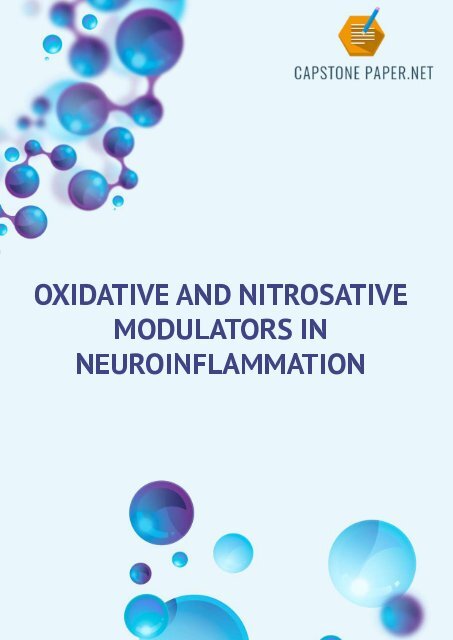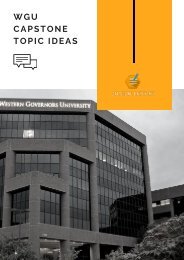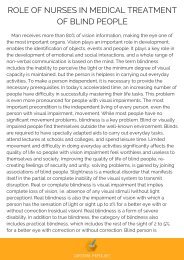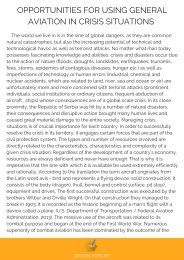Oxidative And Nitrosative Modulators In Neuroinflammation
Are you looking for nursing capstone paper sample? Check it out here: https://www.capstonepaper.net/
Are you looking for nursing capstone paper sample? Check it out here: https://www.capstonepaper.net/
- No tags were found...
Create successful ePaper yourself
Turn your PDF publications into a flip-book with our unique Google optimized e-Paper software.
OXIDATIVEANDNITROSATIVE<br />
MODULATORSIN<br />
NEUROINFLAMMATION
OXIDATIVEANDNITROSATIVEMODULATORSINNEUROINFLAMMATION
OXIDATIVEANDNITROSATIVEMODULATORSINNEUROINFLAMMATION
OXIDATIVEANDNITROSATIVEMODULATORSINNEUROINFLAMMATION<br />
Clinicalevaluationofthedisease:ForalKISandRRMSpatients,theclinicalpresentationwasevaluated<br />
clinicalimagesforfurthertestingpurposes.<br />
-Biochemicalanalyzes:<br />
usingtheKurtzke'sExtendedDisabilityStatusScale(EDSS)scale(Kurtzke,1983).ComparedtothefrequencyofEDSSvaluesobtained,alpatientsweresubdividedintosubgroupswithmildtomoderateorsevere<br />
BloodsamplingandCSTBloodandliverweresampledatthesametime.<strong>In</strong>alpatients,bloodwassampledbyvenipunctureofaneccubicveinafter12hoursofstarvation,inthemorning,intubescontaining500<br />
mM EDTAasananticoagulantforthepurposesofdeterminingbiological-biochemicalinflammatoryparametersoftheinflammation,orinheparinizedtubes(foralremaininganalyzes)centrifugedat4500gfor10<br />
minutes,afterwhichtheplasmawasseparatedandstoredat-80Cuntiltheplannedbiochemicalanalyzes<br />
werecariedout.TheremainingerythrocyteswerewashedthreetimesincoldFR,andthenhemolizedby<br />
theadditionof9equivalentamountsofcolddemineralizedwaterafterwhichthehemolysateswerestored<br />
at-80°Cuntiltheanalysiswascariedout.Nosamplewasolderthan6monthsatthetimeofconducting<br />
wereobtainedbylumbarpunctureofthesubarachnoidspaceinthelying,lateralposition,atthelevel<br />
L3-L4.Aportionofthesampleswasusedforcytologicalanalyzesandisoelectricfocusingneeds,andthe<br />
partwasimmediatelycentrifugedat10,000gfor3minutesat4°Ctoremovecelularelements,andthen<br />
frozenat-80°Cuntiltheplannedbiochemicalanalyzeswerecariedout.Therewerenosignsofbleeding<br />
inthesamples.Theresultsofisoelectricfocusingwereinterpretedinrelationtothepresenceorabsence<br />
ofoligoclonaltapeinthecerebrospinalfluidwiththecorespondingserum finding.PermeabilityofKMB<br />
wasassessedbytheratioofalbuminconcentrationintheserum ortothecerebrospinalfluid.<br />
sulfanilamidein1M HClplus0.15% N-(1-naphthyl)ethylenediaminedihydrochlorideindistiledwater)in<br />
plasmaandcerebrospinalfluid(NavaroGonzalvezetal,1998).<br />
theanalysis.Alsampleswereonlyexposedtoroom temperatureduringtheanalysis.Albiochemicalanalyzeswerecariedoutatthe<strong>In</strong>stituteofBiochemistryoftheMedicalFaculty.Cerebrospinalfluidsamples<br />
ConcentrationofnitrateandnitriteConcentrationofNO.wasdeterminedbymeasuringtheconcentrationofNO2andNO3(µmol/l),usingtheGriessdirectspectrophotometricmethod(Griessreagent:1.5%<br />
MalondialdehydeconcentrationMDAconcentrationwasdeterminedinplasma,haemolysatesandcerebrospinalfluidsbyspectrophotometricmethodwiththiobarbutyricacid(TBA).TheconcentrationofTBARS<br />
wasexpressedastheconcentrationofMDA(µmol)perliter(plasmaandliver),orgHb(hemolysate)(<strong>And</strong>reevaetal.,1988).
OXIDATIVEANDNITROSATIVEMODULATORSINNEUROINFLAMMATION<br />
ConcentrationofadvancedproteinoxidationproductsTheconcentrationofAOPPwasdeterminedin<br />
plasma,haemolysatesandcerebrospinalfluidsusingH2O,KIandaceticacidbyspectrophotometricmethod<br />
at340nm (Witko-Sarsatetal1996).Thevaluesobtainedwereexpressedasµmolperliter(plasmaand<br />
cerebrospinalfluid),orgHb(hemolysate).<br />
ConcentrationofsulfhydrylgroupsThetotalamountof(proteinandnon-protein)SHgroupswas<br />
determinedinplasmaandliver,whileinthehemolysatestheconcentrationofGSHwasdeterminedusing<br />
thespectrophotometricmethodusingDTNB(SedlakandLindsay,1968).Thevaluesobtainedwere<br />
expressedasµmolperliter(plasmaandcerebrospinalfluid),orgHb(hemolysate).<br />
ActivityofsuperoxidedizmutaseSODactivitywasmeasuredbythemethodofMinamiandYoshikawa<br />
(1979),whichisbasedontheinhibitionofautoxidationofpirogalol.Asuperoxideanionformedby<br />
autoxidationofpyrogalolformsacoloredcompoundwithNBT.AstheO2-Purifier,SODinhibitsthis<br />
reaction,whereoneunitofenzymaticactivityrepresents50% inhibition.Thevaluesobtainedare<br />
expressedasUperliter(plasmaandcerebrospinalfluid),orgHb(hemolyzate).<br />
RadiologicalfindingTheCNStissuewasexaminedwithamagneticresonancewith1.5T(Avanto,<br />
Siemens,Erlangen,Germany).TheMRprotocolincludedthefolowingconventionalspinsequences:axial<br />
T1-weighted(VR)=500miliseconds,EVA=78miliseconds,numberofexcitations(BE)=2)and<br />
T2-weighted(VR=4700miliseconds,EV=93miliseconds,BE=2)withacross-sectionthicknessof5mm,<br />
andaspacebetweenthecross-sectionof0.5mm andapixelsizeof0.9x0.9mm.Anintravenously<br />
administeredGd-ContrastAgent(Gadovist,Schering,Berlin,Germany)atadoseof0.1mmol/kgbody<br />
weight.Thenumberand/orvolumeofhyperintensechangesseenonT2sequencesaswelasthevolume<br />
ofGdbindingchangesseenonT1sequencesweretakenforanalysispurposes.AlMRfindingswere<br />
interpretedbyaneuroradiologistwhodidnothaveaninsightintoaclinicalfinding,noradiagnostic<br />
classificationofpatients.<strong>In</strong>relationtothenumberofdescribedchanges,divisionwasmadewithinboth<br />
groupsofpatientstothosewithlowerandthosewithagreaternumberofradiologicalchangesthanthe<br />
meanwithineachgroup.
OXIDATIVEANDNITROSATIVEMODULATORSINNEUROINFLAMMATION
OXIDATIVEANDNITROSATIVEMODULATORSINNEUROINFLAMMATION<br />
Thepresenceofoligoclonaltape(OKT+)ontheisoelectricfocusingofthecerebrospinalfluidandserum in<br />
relationtothenumberofKISpatients(15patients)withOKT+,p=0.025,wasdemonstratedinalarge<br />
numberofRRMSpatients(54patients).TheKMBdisorder,definedasanincreaseinthealbuminconcentrationinthedrugrelativetoserum<br />
levels>7.0x10-3,wasobservedin7KISand11RRMSpatients.<strong>In</strong>other<br />
patients,thediferencesintheassessmentofpermeabilityofKMBbetweentheKIS(5.9±0.95)andRRMS<br />
(6.2±0.7)patientswerenotstatisticalysignificant(p=0.08).Thetotalproteinconcentrationsinthecere-<br />
brospinalfluidwerehigherinRRMS(0.42±0.23g/L)comparedtopatientsoftheKISgroup(0.32±0.13<br />
g/L),p=0.032.Nostatisticalysignificantdiferenceinalbuminconcentrationinthecerebrospinalfluid<br />
wasobservedbetweenKIS(0.25±0.1g/L)andRRMSpatients(0.27±0.1g/L),p=0.07.Also,comparing<br />
totalplasmaproteinconcentrationsbetweenKIS(64.2±12g/L)andRRMS(60.2±10.2g/L)groups,and<br />
plasmaconcentrationsofalbuminKIS(42.3±9.5g/L)andRRMS(43.9±11.1g/L)groups,statisticaly<br />
significantdiferenceswerenoticed,p=0.072ip=0.084.<br />
-NeurologicalfindingsofKISandRRMSpatients:Themajorityofpatientswerefoundtohavesymptoms<br />
andsignsofafectionofmorethanoneCNSfunctionalsystem,inbothKIS(35patients)andRRMSgroup<br />
(47patients),p=0.035(KISvs.RRMS).<strong>In</strong>otherpatients,bothgroupsofthedominantneurologicalfindings<br />
werepyramidal(KIS-11,RRMS-9patients),p=0.075,andsensory(KIS-3,RRMS-1patient)damage,as<br />
welasvisualimpairment(KIS-1patient).Statisticalsignificancewasobservedinthediferenceinthedu-<br />
rationofthesymptomsuntilthepatientarivedatahospitaltreatmentinaKISpatientwithalarger(me-<br />
dianvalueof1month(1-12months)comparedtoKISpatientswithasmalerEDSS(Medianvalue4<br />
months(1-12months),p=0.025.Bycomparingthedurationofthedisease(from themomentofdiagnosis<br />
ofthedefinitiveRRMS),itwasfoundthatRRMSpatientswithahigherEDSShavealongerdurationofthe<br />
disease(medianvalue96months(8-396months)comparedtothosewithalowerEDSS(medianvalue46<br />
months(1-250months)(p=0.0013).ComparisonofotherobtainedvaluesinsubgroupsofKISandRRMS<br />
patientsdividedbyEDSSfindingsdidnotshowstatisticalysignificantdiferences(p>0.05).<br />
-RadiologicalfindingsofKISandRRMSpatients:Datarelatedtotheradiologicalfindingindicatethatthe<br />
existenceofT2hyperintensesignals(p=0.035,RRMSvs.KIS)wasobservedin37patientsintheKISgroup<br />
andalRRMSpatients.ThesedatawereobtainedbasedontheresultsoftheMRconductedduringthecurrenthospitalization,aswelastheinsightintotheearliermedicalrecordsofpatients.Forthepurposesof<br />
moredetailedanalysisinthisstudy,onlyMRfindingsthatweremadeduringthecurenthospitalization<br />
wereusedin16patientswithKISand15patientsintheRRMSgroup.Itwasfoundthatthetotalnumber<br />
andnumber
OXIDATIVEANDNITROSATIVEMODULATORSINNEUROINFLAMMATION<br />
ofsupranuclearhyperintensesignalsseenontheT2sequencewasstatisticalysignificantlyhigherinthe<br />
RRMSgroupofpatients(medianvalueforthetotalnumberoflesionsandthenumberofsupratentorallo-<br />
numberofsupratentorallesions-8(0-80),p=0.023ip=0.03.ThevolumeofGdbindinglesionsseenon<br />
theT1sequencewasstatisticalysignificantlyhigherintheRRMSgroup,bothinthebrain(277.7±109.1<br />
mm3)andinthebiomass(641.3±210.2.1mm3),incomparisonwiththesamefindinginthebrain(146.5±<br />
46.8mm3)andcysticmoss(446.6±120.1mm3)ofpatientsintheKISgroup,p=0.031(forthebrain),p=<br />
0.04.<br />
-Concentrationsofexaminedparametersinrelationtopatientage:Itwasfoundthatolderpatientshad<br />
calizationlesions-40(5-84supratentoral,3-70infratentionallocalization)comparedtothesamecharac-<br />
teristicsinKISpatients(medianvalueforthetotalnumberoflesions-9(0-56),medianvalueforthetotal<br />
higherconcentrationsofNO2andNO3comparedtoyoungerpatients,andinKIS(plasma-p=0.034,cere-<br />
brospinalfluid-p=0.04),andintheRRMSgroup(plasma-p=0.03;cerebrospinalfluid-p=0.025).Simi-<br />
larly,theconcentrationofMDAinalinvestigatedmediawashigherintheelderlygroupcomparedto<br />
youngerpatients,inbothexaminedgroups,KIS(plasma-p=0.07;cerebrospinalfluid-p=0.06;hemolysate-p=0.09),andintheRRMSgroup(plasma-p=0.055;cerebrospinalfluid-p=0.065;hemolysate-p=<br />
0.06).AOPPconcentrationsincreasedinthegroupofelderlypatientsandinKIS(plasma-p=0.05;cerebro-<br />
observedinelderlypatientscomparedtoyoungerandKIS(plasma-p=0.025,cerebrospinalfluid-p=0.04,<br />
inKIS(plasma-p=0.065;cerebrospinalfluid-p=0.031;haemolysate-p=0.05)andinRRMSpatients<br />
(plasma-p=0.025;-p=0.07).<br />
-Concentrationsofexaminedparametersinrelationtohalfofpatients:Analysisoftheobtainedvaluesof<br />
thetestedparameters,comparedtohalfofpatients,itwasfoundthatmenhavehighervaluesofNO2and<br />
NO3concentrationsinrelationtowomen,andinKIS(plasma-p=0,06,cerebrospinalfluid-p=0,075),and<br />
spinalfluid-p=0.06;hemolysate-p=0.055),andintheRRMSgroup(plasma-p=0.06;=0.04;hemoly-<br />
sate-p=0.095).Atthesametime,thedecreaseinSHvaluesinplasmaandliver,GSHinhemolysateswas<br />
hemolysate-p=0.9)andinRRMSpatients(plasma-p=0.015;cerebrospinalfluid-p=0.035;hemolysatep=0.75).ThetrendofdeclineintheactivityofSODwiththeincreaseintheyearsoflifewasalsoobserved<br />
intheRRMSgroup(plasma-p=0,065;cerebrospinalfluid-p=0,023).TheconcentrationofMDAinalinvestigatedmediawasselectivelyhigherinwomencomparedtomen,inbothexaminedgroups,KIS(plasma<br />
-p=0.078,cerebrospinalfluid-p=0.045,hemolysate-p=0.9),andintheRRMSgroup(plasma-p=0.85;<br />
cerebrospinalfluid-p=0.95;hemolysate-p=0.6).
OXIDATIVEANDNITROSATIVEMODULATORSINNEUROINFLAMMATION<br />
ConcentrationsofAOPPshowedanincreaseinconcentrationinmenversuswomenandinKIS(plasma-p=<br />
0.58,cerebrospinalfluid-p=0.6;haemolysate-p=0.55),andinRRMSpatients(plasma-p=0,06;<br />
cerebrospinalfluid-p=0.06;hemolysate-p=0.55).ThedecreaseinthevalueofSHgroupsinplasmaand<br />
liver,ieGSHinhemolysates,inwomenversusmenandinKIS(plasma-p=0.095;cerebrospinalfluid-p=<br />
0.055;hemolysate-p=0.65)andRRMSpatients(plasma-p=0.025;cerebrospinalfluid-p=0.025;<br />
hemolysate-p=0.07).ThedeclineinSODactivitywasmoredominantinwomencomparedtomenandin<br />
KIS(plasma-p=0.075,cerebrospinalfluid-p=0.3;hemolysate-p=0.05)andinRRMSpatients(plasmap=0.065;=0.03;hemolysate-p=0.045).<br />
REFERENCES<br />
Polman,C.H.,Reingold,S.C.,Banwel,B.,Clanet,M.,Cohen,J.A.,Filippi,M.,Fujihara,K.,Havrdova,E.,Hutchinson,M.,<br />
Kappos,L.,Lublin,F.D.,Montalban,X.,O'Connor,P.,Sandberg-Wolheim,M.,Thompson,A.J.,Waubant,E.,Weinshenker,<br />
B.,Wolinsky,J.S.(2011).Diagnosticcriteriaformultiplesclerosis:2010RevisionstotheMcDonaldcriteria.Ann.<br />
Neurol.69(2),292-302.<br />
Lublin,F.D.,Reingold,S.C.(1996).Definingtheclinicalcourseofmultiplesclerosis:resultsofaninternationalsurvey.<br />
NationalMultipleSclerosisSociety(USA)AdvisoryCommiteeonClinicalTrialsofNewAgentsinMultipleSclerosis.<br />
Neurology46,907-11.<br />
Kurtzke,Ј.F.(1983)Ratingneurologicimpairmentinmultiplesclerosis:Anexpandeddisabilitystatusscale(EDSS).<br />
Neurology33,1444–52.<br />
Navaro-Gonzalvez,J.A.,Garcia-Benayas,C.,Arenas,J.(1998).Semiautomatedmeasurementofnitrateinbiological<br />
fluids.Clin.Chem.44,679-81.<br />
<strong>And</strong>reeva,L.I.,Kozhemiakin,L.A.,Kishkun,A.A.(1988).Modificationofthemethodofdetermininglipidperoxidation<br />
inatestusingthiobarbituricacid.Laboratornoedelo,11,41-3.<br />
Witko-Sarsat,V.,Friedlander,M.,Capeilere-Blandin,C.,Nguyen-Khoa,T.,Nguyen,A.T.,Zingraf,J.,Jungers,P.,<br />
DescampsLatscha,B.(1996).Advancedoxidationproteinproductsasanovelmarkerofoxidativestressinuremia.<br />
Kidney<strong>In</strong>t.49,1304-13.<br />
Sedlak,J.,Lindsday,R.(1968).Estimationoftotalproteinboundandnon-proteinsulphydrylgroupsintissuewith<br />
Elman’sreagent.AnalBiochem,25,192-2.<br />
Minami,M.,Yoshikawa,H.(1979).Asimplifiedassaymethodofsuperoxidedismutaseactivityforclinicaluse.Clin.<br />
Chim.Acta,92,337-42.

















